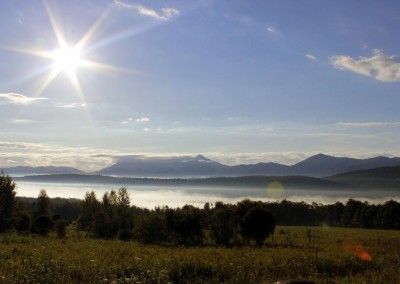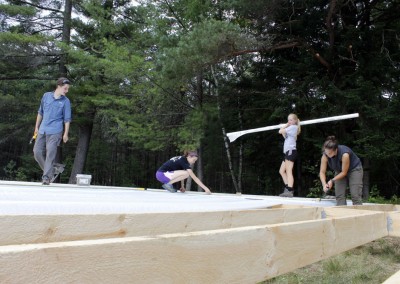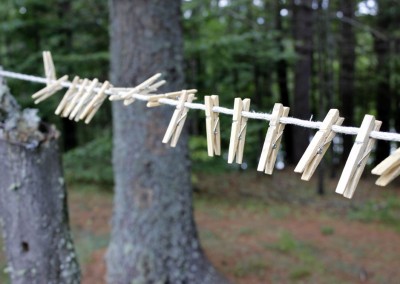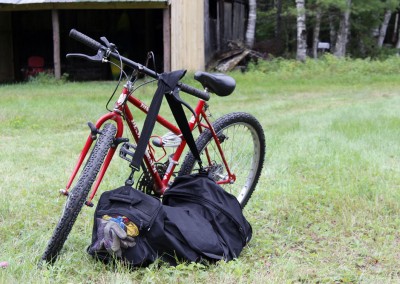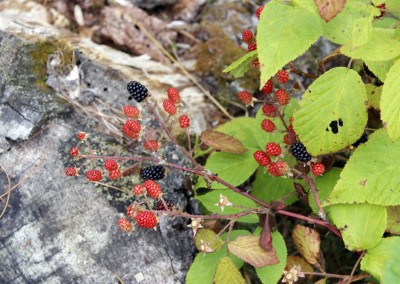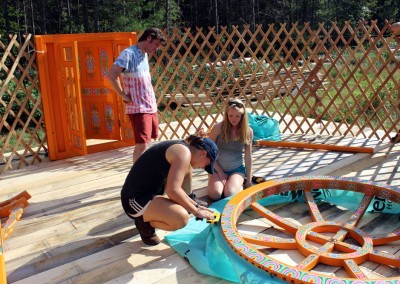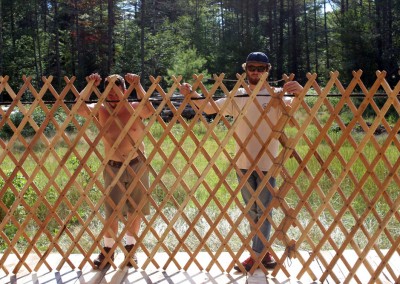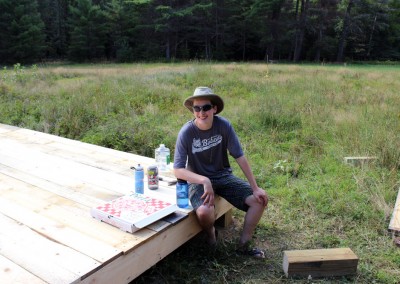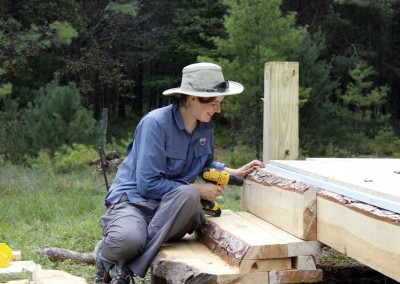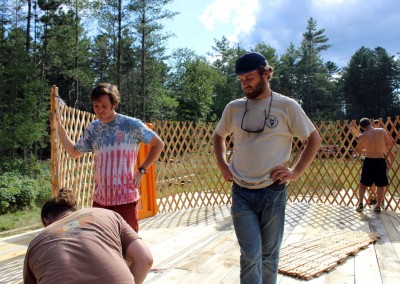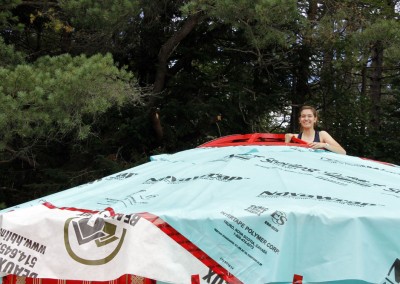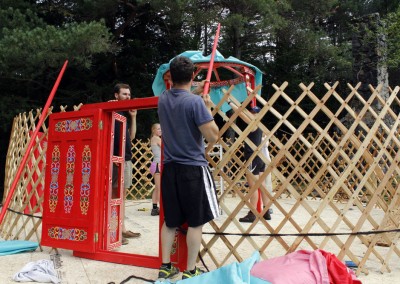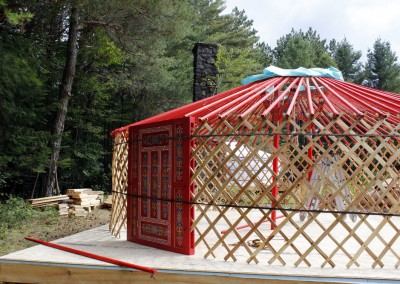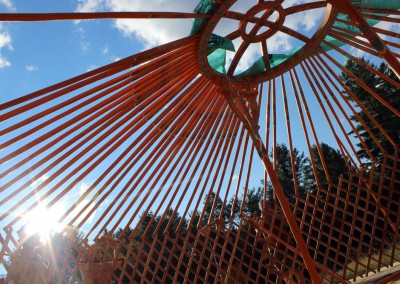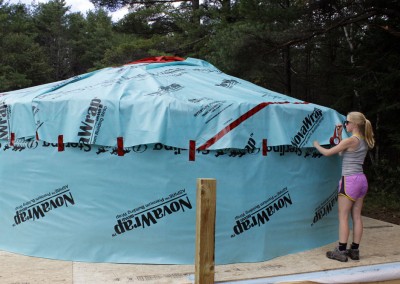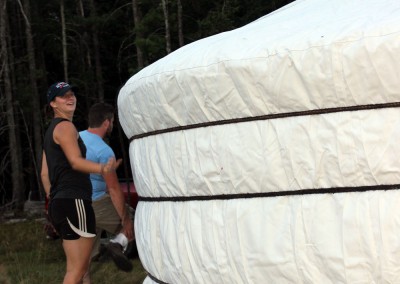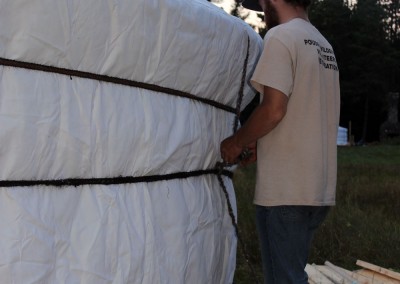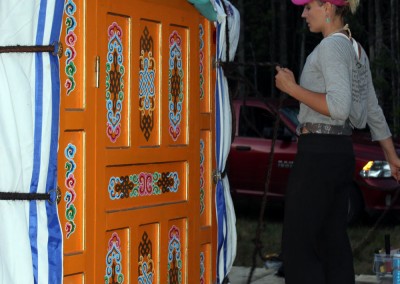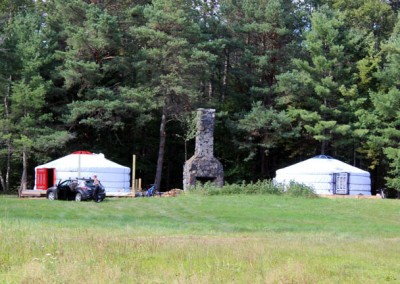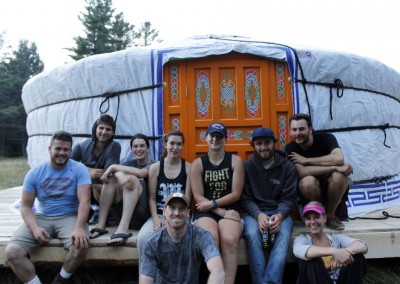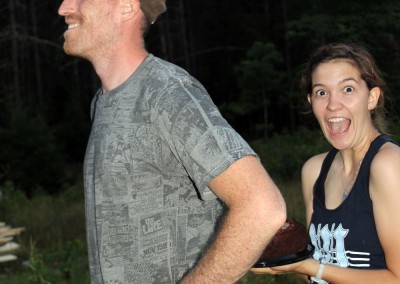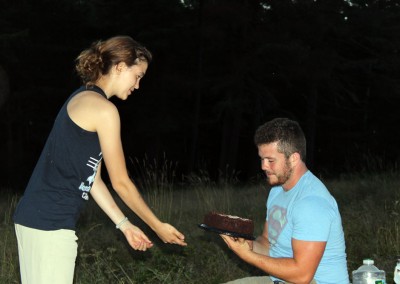by Bethany Garretson | Aug 15, 2015
After four days of sun, sweat and downpours, a platform rose, and on it, an authentic Mongolian yurt. See how Joe Orifice, Andy and Phil Johnstone, Bethany Garretson and Alex Hall turned nine holes in the ground into an authentic Mongolian structure.

It began with nine posts.

Who needs a truck?

Phil Johnstone lends a helping hand.

The chimney works!

Alex Hall and Andrew J give a wave as the canvas is tied.

With the yurt up, only decking remains.

The smell of wood smoke is fitting as the yurt is raised.

Who doesn’t love a good fire?

One down, two to go.
by Bethany Garretson | Aug 15, 2015
It’s May and I’m sitting across from Joe Orefice in Freer, trying to follow along as he sketches out a yurt platform.
“You’ll need some L-angle brackets,” he says, tapping the pencil against the paper. I nod like I know what an L-angle bracket is and add it to the growing list of supplies.

Loons sang on Osgood Pond.
6x6x12 Pressure treated (PT)
Decking Screws
Nails
Plywood
Insulation
Building is a new language to me. There are words like flush and joist, codes and acronyms—lingo that makes my head confused and slightly ache. I appreciate Joe’s help and the time he’s volunteered for this project. I appreciate that he’ll teach Andrew J and I how to build a platform. Not only that, but the wood we’ll be using for the deck was milled by Joe and his spring class. Timber harvesting…an amazing art, that too was foreign to me until this project.
Purchase orders
It’s the first of June and I’m pulling into Curtis Lumber in Ray Brook. Clutching the final list of supplies, I talk to a kind woman behind the counter. She punches the order into the computer and walks me around the store.

Letting go of stresses.
“What kind of toilet seat do you want?”
I stare at a rack—scanning prices and colors.
“Um, that one.” I point to a beige, mid-range seat that looks comfortable enough for an outhouse. She slides it off the rack. A few days later, the supplies come and are put into storage. I appreciate the woman at the store. I appreciate the workers who delivered the supplies and our facilities crew for storing them. I appreciate all the things that happen behind the scenes that sometimes go unrecognized.
Building and fire codes
Enter June 12: The day Andy and I are about to start digging. A fire inspector from Albany is on campus. He asks me about the yurts.

Blueberries and raspberries.
“Have you filled out a building permit?”
“No.” I explain yurts are classified as tents and temporary structures. After fielding an array of questions, he gives me his card and says he’ll be in touch. As I step back into the sunlight, I’m left with an uneasy feeling and we leave the shovels in the car.
I appreciate concern. I appreciate resilience.
Nerves and fear of the unknown
July: I get in the habit of wondering, “What next?” First it was a battle for an idea, then a battle for budget, now it’s permits and fire codes. I’m nervous and fearful as I watch the days slip away. August is around the corner. Are we on schedule? No. Do we still have time? Yes. There are many things I thrive with under the pressure of a nearing deadline—research papers for one.

A home on Easy Street.
Andrew J and I moved out of the house we were renting July 1, with the expectation we’d be moving into a yurt. I appreciate Hal Beck—our good friend whose let us occupy his 8′ x 16′ cabin on Easy Street. I appreciate how communities come together when someone is in need.
Partnership
It’s raining. It’s August 11th. It’s crunch time. Joe meets Andy and I at the facilities building at 11. I’m not in a great mood. I haven’t been feeling well the last two weeks. Maybe it’s stress, maybe it’s a chronic illness or maybe I just need to get my hands in the soil.
And that’s exactly what I do.
By the end of the day, we have the 6x6x12 posts sunk securely into the ground and a few joist across the frame. I have scratches and my hands are dirty. It feels amazing. I appreciate partnership. I appreciate Joe and Andrew J stepping up when I needed to step back. I appreciate the extra help we got from our past co-worker and Paul Smith’s alumni, Reid Mourse.

Phil Johnstone.
I appreciate the tutelage, advice and extra man power from Andrew J’s father, Phil Johnstone. A retired DEC man, he teaches me the basics of silvi-culture and how to care for our wood lot.
Lessons
I can make cordage out of milkweed. I can treat poison ivy with Jewel weed. I can make a birch basket and collect quarts of berries to eat and dry. I can do a cart wheel, round off and split.
There are many things I can do and that I’m good at. Some, I even excel. And, there are things I’m not good at and come no where close to excelling.

We can do so much with the simplest of things.
This project opened another door to introspection and exposed my strengths and weaknesses in a different light. It’s important to admit, we can’t do it all and no one is an expert of everything. That’s why it’s important to live in community and foster partnerships.
I appreciate my strengths. I appreciate my weaknesses. I appreciate the fabric that makes us unique characters. And how one person’s strengths compliment anothers weakness.
Excitement
I read their emails and it jumps out at me and bites: Excitement.
Andrew C shares a design for a manual powered washing machine.
Kade and Hyla will be back in the area for canoe preseason and ask if they can camp on site.
Brady is bringing his mandolin.
Valerie writes, “This is the most excited I’ve ever been to come back to school.”

Excitement!
I appreciate their excitement. And I feel the same. I think back to high school, college, grad school, and teaching… yep, this is the most excited I’ve ever been to go back.
And, here we go…
by Bethany Garretson | Aug 1, 2015
August is here, and with the end of July came the beginning of the yurts. A week ago, I went out to the yurt site with a roll of mason line, string level, square, tape measure and an axe. Some time in the nearby woods yielded nine strong sections of tree branch I shaped into posts, and then it began — the laying out of the grid. It was no quick task, but after some time we had a 24′ by 24′ square, the platform to be.

The grid beside the old chimney.
A couple of days later, the shoveling began. The final week of the month went out in a hot-and-humid fashion. Excavation for the post holes went about as well as it could have. Seven of the nine, after getting through the first foot of sod and stone, were nothing but sand below. The other two argued some: Stones the size of soccer balls, possibly from the old boy scout camp foundation, filled the first. Out came the axe for the other as root after root got in the shovels way.
Bethany, meanwhile, spent the summer hours nearby collecting pint after pint of blueberries and raspberries. The two are peaking right now, and though blackberries are still two weeks out, we now have a freezer full of wild Adirondack fruit. After the final shovel full of sand came out, we reconvened and celebrated the groundbreaking over a handful of sweet berries.

The blueberries are in their prime — not a bitter one to be found.

Berries are in full swing as August begins.
On Thursday, we returned with some scrap plywood to cover up the holes before the coming rain. Bethany made her way back to the berry patches with a container in hand that wouldn’t be empty much longer while I hauled the wood over. I got to the first hole and looked down.
Garter snake.
I chuckled at the little fella’s misfortune, reached in and hauled the creature out. It took off as soon as it hit the grass. I got back to work, and two holes later, another legless find. Only this time, it was a kind I had never seen before. Smaller than the garter snake, this one was dark gray with a bright orange belly and an orange ring around the neck. Skeptical about handling a mystery snake, I paused for a moment. Definitely not a rattler, but I grabbed my phone and did some quick investigating.
The mystery reptile was a Diadophis punctatus, or ringneck snake. Venomous, but hardly, and considered safe to handle by humans. After getting it out of the hole, I released it beside some nearby stones. It lingered there while I finished the task and called for Bethany to see the snake. By the time she arrived, it had disappeared. I looked back at one of the now plywood covered-holes, had an ‘ah-ha’ moment, and uncovered it. Sure enough, there it was, only this time it was joined by the same garter snake I had pulled from a different hole.
It’s no wonder that pit traps are one of humans’ earliest known methods of capturing prey.

Our inadvertent snake trap.
The second time I took the snakes out, I brought them some distance away to a pile of old wood. Good cover and maybe far enough from the holes that I didn’t have to worry about checking them every day for creatures that found the holes to be without an exit.
Another handful of berries and we packed up. Soon the holes will be filled with something else: The posts bearing a platform and yurt.

